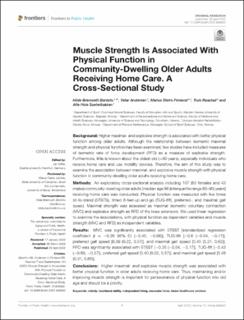| dc.description.abstract | Background: Higher maximal- and explosive strength is associated with better physical function among older adults. Although the relationship between isometric maximal strength and physical function has been examined, few studies have included measures of isometric rate of force development (RFD) as a measure of explosive strength. Furthermore, little is known about the oldest old (>80 years), especially individuals who receive home care and use mobility devices. Therefore, the aim of this study was to examine the association between maximal- and explosive muscle strength with physical function in community-dwelling older adults receiving home care. Methods: An exploratory cross-sectional analysis including 107 (63 females and 43 males) community-dwelling older adults [median age 86 (interquartile range 80–90) years] receiving home care was conducted. Physical function was measured with five times sit-to-stand (5TSTS), timed 8-feet-up-and-go (TUG-8ft), preferred-, and maximal gait speed. Maximal strength was assessed as maximal isometric voluntary contraction (MVC) and explosive strength as RFD of the knee extensors. We used linear regression to examine the associations, with physical function as dependent variables and muscle strength (MVC and RFD) as independent variables. Results: MVC was significantly associated with 5TSST [standardized regression coefficient β = −0.26 95% CI (−0.45, −0.06)], TUG-8ft [−0.6 (−0.54, −0.17)], preferred gait speed [0.39 (0.22, 0.57)], and maximal gait speed [0.45 (0.27, 0.62)]. RFD was significantly associated with 5TSST [−0.35 (−0.54, −0.17)], TUG-8ft [−0.43 (−0.60, −0.27)], preferred gait speed [0.40 (0.22, 0.57)], and maximal gait speed [0.48 (0.31, 0.66)]. Conclusions: Higher maximal- and explosive muscle strength was associated with better physical function in older adults receiving home care. Thus, maintaining and/or improving muscle strength is important for perseverance of physical function into old age and should be a priority. | en_US |

